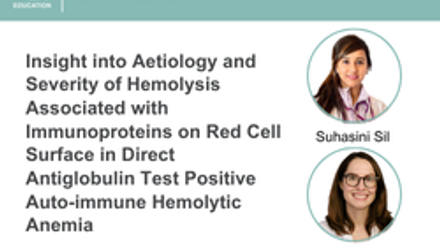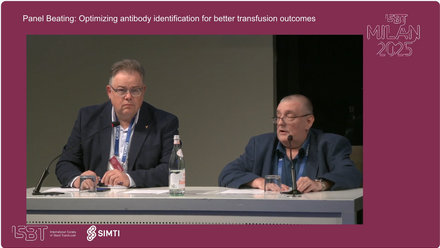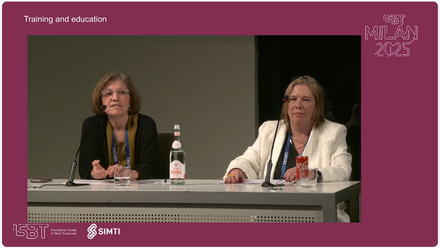The Crossmatching 2.0 session included the following presentations:
1. Christine Lomas Francis: CD47 Biotherapy: A new incompatibility threat
2. Tae-Shin Kim: The effects of IMC-002, a novel anti-CD47 monoclonal antibody, on pretransfusion compatibility testing
3. Wenhui Li: CD71+ RBCs Mediate Increased Erythrophagocytosis and Reduced Monocytes in Human Suspension Assay
4. Ling Wei: Evaluating the clinical significance of alloantibodies against GP.Mur using flow cytometry phagocytosis assay
5. Anne Cornelissen: Detection of erythrocyte alloantibodies in patient sera using a novel flow cytometry approach
MODERATORS: Sofia Lejon Crottet, Roland Fiskesund
After the presentation, there was a questions and answers session, which is also included in the recording.
Abstract
Evaluating the clinical significance of alloantibodies against GP.Mur using flow cytometry phagocytosis assay
S Zhu1, L Wei1, J Wen1, Z Liao1, G Luo1, Y Ji1
1The Institute of Clinical Blood Transfusion, Guangzhou Blood Centre, Guangzhou, China
Background: Mur glycophorin expresses five kinds of low-frequency antigens including Mia, Mur, Hil, MINY and MUT. Alloantibodies against GP. Mur commonly are the mixed antibodies against multiple antigens carried by GP. Mur, which can be termed anti-Mi(a), and sometimes the specific antibody against single antigen. But the antibody identification for specificity is hard to be conducted since lacking a panel of cells with the rare glycophorin phenotype. In the Southeast Asia population with the high-frequency distribution of GP. Mur, anti-Mi(a) is commonly encountered, which could lead to haemolytic transfusion reaction and haemolytic disease of the foetus and newborn (HDFN). Usually, it causes only mild clinical symptoms, but in some cases, it can cause severe outcomes such as hydrops fetalis or even foetal death. The FCM phagocytosis assay has been established in previous studies to successfully predict the severity of clinical outcomes of alloanti-D. However, whether the assay could also be used for the prediction of the severity of clinical outcomes of anti-Mi(a) is unknown.
Aims: To attempt to use a flow cytometry phagocytosis assay to predict the clinical significance of anti-Mi(a).
Methods: Plasma of patients with anti-Mi(a) was collected. DTT was used to destroy the IgM of anti-Mi(a) in the plasma and retain the IgG anti-Mi(a). RBCs with GP. Mur phenotype were sensitized by the treated plasma containing IgG anti-Mi(a) respectively. A new Flow cytometry (FCM) two-colour phagocytosis assay was performed to analyse the phagocytic efficiency of monocytes on the sensitized RBCs. The titration of the anti-Mi(a) was also conducted. And the relationship between titters and phagocytic efficiency was analysed. The plasma from a special case of severe HDFN identified with anti-E combined with anti-Mur was also investigated by FCM phagocytosis assay to determine which antibody lead to the clinical outcomes.
Results: The phagocytic efficiency of monocytes was around 50%~80% when the RBCs are sensitized by anti-Mi(a) from severe HDFN or hydrops fetalis patients (n = 3), while were less than 13% when the anti-Mi(a) are from patients with no related clinical outcomes (n = 7). The phagocytic activity of monocytes mediated by anti-Mi(a) was correlated with the antibody titters. The phagocytic efficiency was less than 30% when antibody titters were lower than 8 and increased sharply when titters ranged from 8 to 64, then, plateaued around 80% when titters were above 64. Furthermore, the FCM phagocytosis assay revealed similar phagocytosis activities when using E+Mur– and E–Mur+ RBCs respectively monocytes mediated by anti-E and anti-Mur mixed antibodies in the severe HDFN case.
Summary/Conclusions: FCM phagocytosis assay seems to be an effective method for predicting the clinical significance of anti-Mi(a). Prenatal monitoring should be conducted in pregnant women with anti-Mi(a) with higher phagocytic efficiency than 30%.






